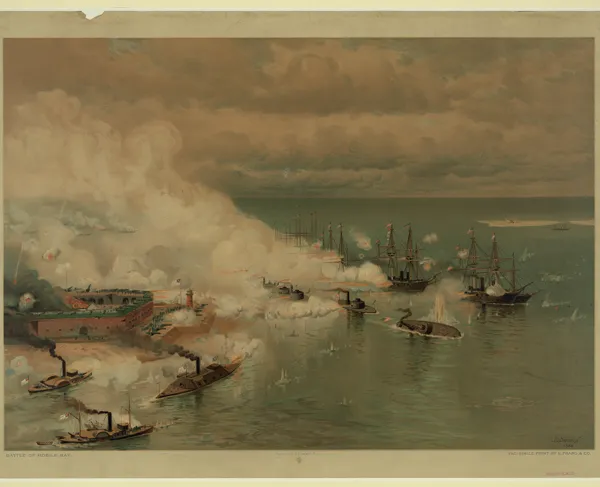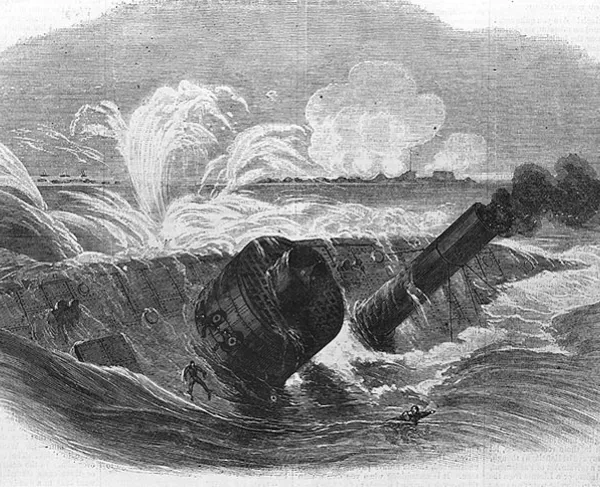Damn the Torpedoes!
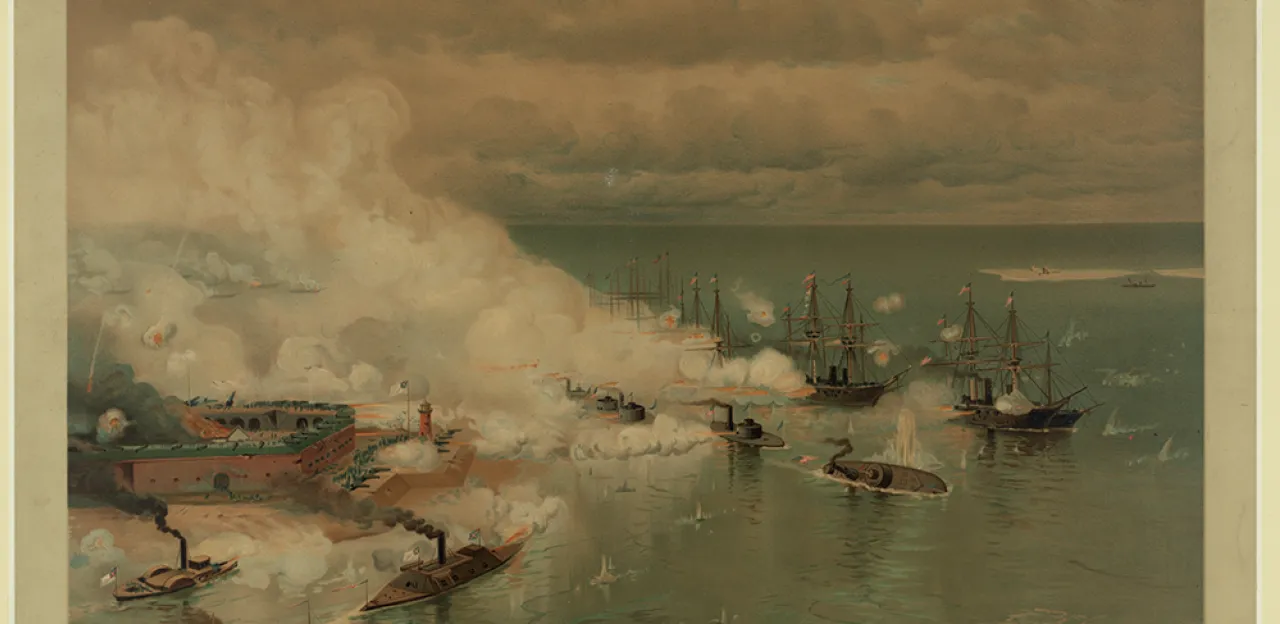
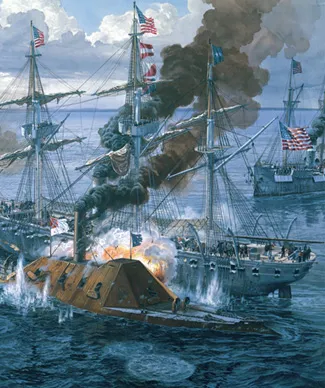
Along with the clash of ironclads in Hampton Roads and the duel between the Alabama and the Kearsarge off Cherbourg, France, the Battle of Mobile Bay is one of the iconic confrontations of the Civil War at sea. Indeed, Farragut’s charge into Mobile Bay in August of 1864 may have been the most dramatic moment of the naval war, comparable to Pickett’s Charge at Gettysburg or the Union assault up Missionary Ridge.
The Battle of Mobile Bay had a dramatic cast of leading characters. Inside Mobile Bay, the Confederacy’s only full admiral, Franklin Buchanan, waited with his flagship, CSS Tennessee, the most powerful rebel ironclad since the Virginia. Buchanan was an old sea dog with an illustrious and lengthy career. He had entered the Navy as a teenager — not unusual in those days — during the War of 1812, first serving under the command of Oliver Hazard Perry, fresh from his immortal victory on Lake Erie. Buchanan had subsequently commanded warships against pirates in the Caribbean, and he led a storming party ashore during the Mexican War to capture an enemy fort. He was the founding superintendent of the U.S. Naval Academy, where the superintendent’s home is named Buchanan House in his honor. Earlier in the Civil War, he had commanded the CSS Virginia during its initial sortie Hampton Roads when it all but destroyed the Union fleet there on March 8, 1862. Badly wounded in that fight, he missed the Virginia’s historic clash with the Monitor the next day. Promoted to full admiral — the only man ever to bear that rank in the Confederacy — he was sent to Mobile Bay to take command of the naval forces there. By August of 1864, he had been a naval officer for 49 years.
As impressive as that is, David Glasgow Farragut, who commanded the Union squadron outside Mobile, had a 51-year naval career that rivaled it. Born James Glasgow Farragut in Tennessee, the future admiral entered the naval service at the age of eight. Even in those days, going to sea at such a tender age was unusual. It came about by accident, or, if you believe in such things, by fate. Having moved his family from Tennessee to New Orleans, Farragut’s father, Jorge Farragut, was fishing one day when he happened upon an elderly man lying unconscious in a small boat. Jorge Farragut brought the man home and nursed him for weeks until his death. He turned out to be 84-year-old David Porter, whose son and namesake was a captain in the U.S. Navy. Out of gratitude for this solicitude, Captain Porter offered to take Jorge Farragut’s son to sea as a midshipman. It was quite a generous offer since such appointments were rare and valued, even more so then than now.
Consequently, David Porter became a kind of surrogate father for the young Farragut, who changed his first name to David to honor his benefactor. He could not adopt his patron’s surname since there was already a David Porter in that generation — the captain’s natural son, whom historians call David Dixon Porter to distinguish him from his father. That is how James Farragut became David Farragut and the foster brother of David Dixon Porter, another key player in the Civil War.
Besides their age and their connection to famous figures from the War of 1812, Buchanan and Farragut also shared the rather curious distinction of having switched sides. Buchanan, born in Baltimore and appointed as a midshipman from Pennsylvania, fought for the South; Farragut, born in Tennessee, raised in New Orleans and married to a Virginian, fought for the North. Thus it was that at Mobile Bay the northern-born southerner Franklin Buchanan awaited an attack by the southern-born northerner David Farragut. Between them they had accumulated a total of 100 years of service at sea.
Mobile Bay also involved ironclad warships. Inside the bay, Buchanan commanded the formidable ironclad CSS Tennessee in addition to two less-efficient ironclads, the Baltic and the Nashville, which were badly underpowered and unlikely to be of much value in combat. Farragut was reluctant to fight his way in until he, too, had some ironclads in his command. The first of them arrived in late July 1864, and by the end of the month he had four. On August 1, Farragut ordered the captains of his wooden steamers to send down their upper yards, stripping away nonessential impedimenta for imminent action. Farragut planned his attack carefully, for he had to worry not only about the Tennessee, but also about the twin forts guarding the entrance to the bay. The larger of these, Fort Morgan, was a star-shaped masonry fortification armed with a score of heavy guns, any one of which was capable of sinking one of his wooden screw steamers. In addition, there were the “torpedoes”— what the Federals called “infernal machines,” and what today would be called mines — that the Confederates had sown in the ship channel. Only a very narrow passage directly under the guns of Fort Morgan had been left unmined for arriving and departing blockade-runners. The smaller Fort Gaines stood on the western side of the bay’s mouth, completing the gauntlet.
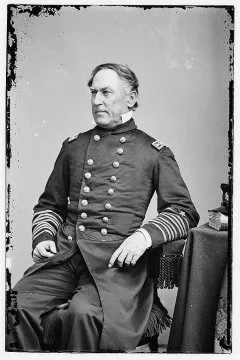
Farragut planned to advance his ships in two columns. The column on the right, or starboard, was closer to Fort Morgan and consisted of his four monitors, with the Tecumseh in the lead. To the left and slightly behind these, Farragut positioned a second column — his wooden warships lashed together so that the more formidable vessels absorbed the bulk of the fort’s guns. The idea was that the bigger ships would screen the smaller ones, and, in addition, if one ship became disabled, the other could pull it through the channel to safety. Farragut did not plan to stop and fight it out with the forts. As he had done on the Mississippi in 1862, he hoped to run past the enemy forts into the bay. Only after he made it past the forts and through the minefield would he worry about Buchanan in the Tennessee.
Farragut expected to lead the attack in his flagship, the wooden-hulled screw sloop Hartford, but at the last minute his captains prevailed upon him to let the sloop Brooklyn go first instead. If the admiral were hurt early in the fight, they argued, it might throw the whole attack into confusion and lead to disaster. Reluctantly, Farragut agreed that the Hartford could go second in line behind the Brooklyn.
August 5th dawned with a gentle haze that turned the sky a milky white and a sea as smooth as glass. As the Federal warships approached the ship channel, the rebel gunners in Fort Morgan fired slowly and deliberately, the shell splashes erupting around the lead ships, which returned fire as their guns bore, the white smoke from their broadsides beginning to obscure their formation.
As the two columns approached the bay’s entrance, Capt. Tunis Craven in the Tecumseh spotted Buchanan’s Tennessee through the narrow viewing slit on his pilothouse. Since Craven’s job was to shield the wooden warships from Buchanan’s Tennessee, he began to edge over to port — that is, to the left — to intercept her. But that pushed the wooden ships in the left-hand column to the left as well, dangerously near the line of buoys marking the edge of the mine field. Seeing the buoys ahead of him, Capt. James Alden, in command of the Brooklyn, ordered his ship to stop.
Behind him, Farragut sent him the flag hoist signal number 665: “Go ahead.” Alden answered by wig-wag, which he calculated would be faster than flag hoist. Unfortunately, the only officers aboard the Hartford who could read a wig-wag signal were army officers currently below deck. After passing the word for the army signal officer, Farragut climbed part way up the rigging to see over the smoke that was billowing about the deck. Worried that the admiral might fall to the deck if he were hit by a splinter, Farragut’s flag captain, Percival Drayton, sent up a signalman with a piece of line to secure the admiral to the rigging. Farragut at first refused, then seeing the wisdom of it, passed the line around his body a few times and gave the loose ends to the signalman, who secured him to the rigging.
Meanwhile, the army signal officer arrived to read Alden’s wig-wag message, which was that the monitors were squeezing the Brooklyn toward the mine field. “We cannot go on without passing them,” Alden signaled. “What shall we do?” Again, Farragut ordered Alden to go ahead. With both columns under fire from the fort, this was hardly the place to stop and have a conversation.
Suddenly, off to starboard of both the Brooklyn and the Hartford, the bow of Craven’s Tecumseh heaved up out of the water, followed quickly by the muffled thump of an underwater explosion. The Union monitor turned over onto its starboard side; its bow plunged downward, its stern rose up, exposing its still-turning brass propeller; and then it shot downward like an arrow and was gone from sight. The whole incident, from explosion to the moment the Tecumseh disappeared, lasted barely twenty-five seconds. All that was left was a handful of survivors flailing in the roiling water where the Tecumseh had been. At least one of the Confederate torpedoes had proved appallingly successful.
While the Tecumseh went down, the Brooklyn was edging even closer to the minefield on the left. Farragut had ordered Alden to keep to the center of the channel, but that was impossible now. Indeed, Alden could not go forward at all without steaming directly into the minefield. Again he ordered the engines stopped, and then he began to back down. The whole Federal movement was about to collapse into confusion and disorder.
This, of course, is when Farragut took matters in hand. In order to avoid having his entire column of ships collide like a collapsing accordion, he ordered the Hartford to pull out of line and steam past the Brooklyn to port, directly through the mine field. As Farragut passed the Brooklyn, Alden called across to him to point out the torpedoes in the water dead ahead. To which Farragut purportedly replied, “Damn the torpedoes!” The phrase has gained immortality in the 150 years since, but, in fact, Farragut had little choice at this point but to go ahead. He could not stop under the guns of Fort Morgan and he could not back down with a column of ships behind him, so he went ahead. The rest of the Federal ships followed him, careful to stay in his wake. As they passed through the minefield, some sailors later claimed they had heard the primers snapping on the torpedoes. Luckily, no more of them exploded, very likely because of faulty primers.
Buchanan watched all this from the pilothouse of the Tennessee, and once it was clear that, except for the unlucky Tecumseh, Farragut’s vessels had survived the run into the bay, he ordered his ship to steam directly for the Hartford, which was now leading the Federal squadron out of the minefield. Alas, the Tennessee’s plodding speed made such an attack an exercise in frustration. Two and a half years earlier, when Buchanan had commanded the Virginia in Hampton Roads, he had been able to ram and sink the Cumberland with relative ease largely because his target had waited passively at anchor to receive the Virginia’s charge. The circumstances in Mobile Bay were quite different. A ship underway had little to fear from an iron-clad ram whose top speed was only six knots. Farragut’s Hartford easily eluded the Tennessee, while gunners on both ships fired at one another. Buchanan made a run at several more of the Federal ships, but failed to make contact. Buchanan then broke off the action, and ordered the Tennessee back to its anchorage off Fort Morgan.
As his ungainly vessel steamed slowly back to Fort Morgan, Buchanan ordered an inspection of her damage. The news was gratifying. Though the exterior accouterments, such as the smokestack, boat davits and handrails, had all been blasted away by fire from the enemy fleet, the armored casemate was undamaged, the engines were sound and there had been no serious injuries.
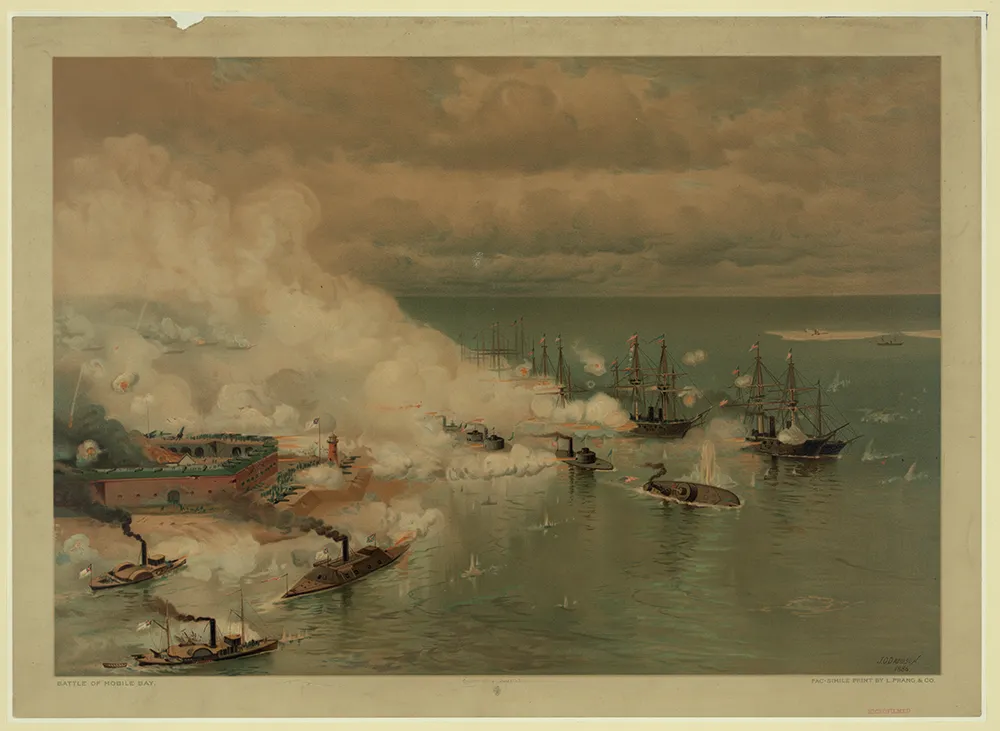
Because the Tennessee had gone into battle before the hands could be fed, Buchanan ordered the crew to breakfast. Afterward, he turned to his flag captain and ordered him to get the Tennessee underway again. “Follow them up, Johnston,” one officer recalled him saying, “We can’t let them off that way.” As the Tennessee moved up the bay, his intentions became obvious to every man on board, and a murmur ran along the deck. One crewman muttered: “The old admiral has not had his fight out yet; he is heading for that big fleet; he will get his fill of it up there.” Another wrote that, “It looked to me that we were going into the jaws of death.” The ship’s surgeon could hardly believe it. “Are you going into that fleet, Admiral?” he asked. “I am, sir,” Buchanan told him. Turning away, the surgeon incautiously ventured the opinion, “We’ll never come out of there whole.” Overhearing the remark, Buchanan instantly rounded on him, “That’s my lookout, sir!”
On board the Hartford, Farragut was surprised that Buchanan planned to renew the fight so soon, but he did not hesitate to order his own vessels to clear for action. He ordered his flag captain to aim the Hartford directly at the approaching vessel. Buchanan, too, sought out the opposing flagship. Like two jousters in some slow-motion medieval tournament, the Hartford (at 10 knots) and the Tennessee (at four knots) steamed directly at one another. At a combined speed of 14 knots, it took 15 minutes for the two ships to cover the four miles that separated them. Had they collided stem-to-stem, the collision would almost certainly have sunk both vessels within minutes. As it was, the steersman on the Tennessee turned slightly to starboard at the last second and the two vessels passed each other port-to-port at point-blank range.
As the two ships scraped past one another, virtually touching, men on both ships screamed insults. Swept up in the fight, they used any weapon at hand: a sailor on the Hartford threw a spittoon and a holystone at the Tennessee; a sailor on the Tennessee leaned out a gun port and stabbed a Federal sailor on the Hartford with his bayonet — the only bayonet wound ever inflicted in a Civil War naval battle. Percival Drayton, Farragut’s flag captain, later claimed that as the two ships slid past one another, he spotted Buchanan through an open gun port and, overcome by fury, threw his binoculars, thundering: “You infernal traitor!”
Once the Tennessee had slipped past the Hartford, it was surrounded by Federal warships all firing as fast as they could load. In less than an hour, the Union double-turreted monitor Chickasaw fired 52 shells into the Tennessee at a distance her commander estimated to be from “50 to 10 yards.” Buchanan could not return fire even though he was literally surrounded by targets for one gun port was jammed shut and the primers regularly misfired on his other five. He called for a party of workmen to try to un-jam the stuck gun port. Two men stood with their backs to the casemate holding a metal bolt over the pivot rod, while two more struck it with sledgehammers. Buchanan was personally supervising their labor when a shell smashed into the casemate directly opposite where they were working. The men holding the bolt died instantly. Buchanan was struck by flying debris and fell to the deck. His left leg — his good leg — suffered a compound fracture and bent out at an impossible angle. Immediately the cry went up that the admiral was hit. “Well, Johnston,” Buchanan told his flag captain, “They have got me again. You’ll have to look out for her now; it is your fight.”
But the Tennessee was already doomed. The fusillade of enemy shells had severed the steering chains on the afterdeck, and the Tennessee’s rudder no longer answered the wheel. Without its steering mechanism, the Tennessee was no longer maneuverable. Moreover, with its funnel shot away, the ship could not raise steam in her boilers. The gun port that Buchanan had tried to clear remained jammed, and the primers on the other guns were unreliable. The Tennessee could not steam, could not maneuver, could not shoot. The situation spoke for itself. “Do the best you can,” Buchanan told his flag captain, James D. Johnston. “And when all is done, surrender.” Johnston wasted little time. Almost at once, he lowered the Confederate flag flying from the pilot house. In the fury of battle, that gesture was ambiguous, and Johnston realized what had to be done. He tied a white handkerchief to a boarding pike and raised it above the ship, and at last the firing stopped.
The wounded Buchanan was taken prisoner and, eventually, sent to New York, where he spent the winter months in Fort Lafayette in New York Harbor. Exchanged in the spring, shortly before Appomattox, he made his way back to Mobile, arriving there just as the war came to an end. As for Farragut, Congress voted him a $50,000 bonus — serious money in those days, equivalent to several million dollars today — and in December, he was promoted to the rank of vice admiral. After the war was over, on July 26, 1866, Congress created the rank of full admiral and named David Glasgow Farragut to fill it. Just as Franklin Buchanan, the northerner who fought for the South, had been the first Confederate admiral, Farragut, the southerner who fought for the North, became the first admiral of the U.S. Navy.
This article originally appeared in the Winter 2008 issue of Hallowed Ground, the Civil War Preservation Trust's award-winning membership magazine.
Dr. Craig L. Symonds is professor emeritus at the U.S. Naval Academy. The first person to win both the Academy’s “Excellence in Teaching” and “Excellence in Research” awards (1988 and 1998, respectively), he also received the Department of the Navy’s Superior Civilian Service medal on three occasions. He has also taught at the U.S. Naval War College in Newport, R.I., and at the Britannia Royal Naval College in Dartmouth, England. Symonds is the author of eleven books, including Decision at Sea: Five Naval Battles that Shaped American History (2005), which won the Theodore and Franklin D. Roosevelt Prize for Naval History. His most recent book is Lincoln and His Admirals: Abraham Lincoln, the U.S. Navy, and the Civil War, published by Oxford University Press in 2008. He and his wife Marylou live in Annapolis, Md. They have one son and one grandson.
Related Battles
322
1,500

